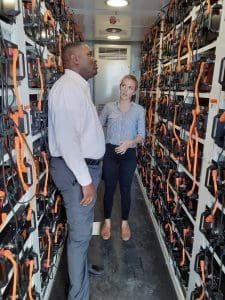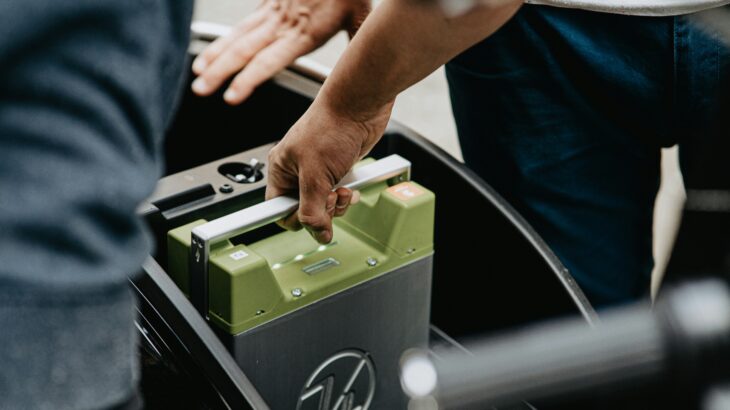
Photo: Minister Curtis Richardson (GoA) and Maura Appleberry (Gridspan) inside the mobile energy storage system
Contributing Authors:
Melissa Meade, Director of Environment, Government of Anguilla; Dallen Connor, Coordinator of Environmental Control and Pollution, Government of Anguilla; Alec Macklis, Founder and CEO, Gridspan Energy
The Caribbean is a hotspot for innovative energy storage, and the new project out of Anguilla is the latest to make a splash. The 125-kW mobile containerized battery system from Gridspan Energy was installed at the Government Headquarters, NBA Building, but can be quickly deployed across the island to make the grid resilient to disruptions.
We spoke with the Government of Anguilla and Gridspan Energy to learn more about why Anguilla chose this technology, the project economics, and what the energy future looks like for the small Caribbean island.
Can you explain why Anguilla chose to pursue this type of technology? What were the main considerations?
While shifting to renewable energy and implementing energy savings initiatives are important priorities, equally important are strengthening the reliability and resilience of critical facilities in light of increasingly powerful storms and hurricanes.
Gridspan’s mobile energy storage systems can be quickly deployed between critical facilities and used for solar or backup power. This kind of flexible energy storage is well-suited to island communities seeking energy savings, reliability, resilience and sustainability.
Anguilla has been a regional thought leader and early adopter of island-centric energy technologies such as this, and we recognize the need to support innovations in sustainable energy transition. The partnership between Gridspan Energy and the Government of Anguilla on this mobile energy storage initiative is an important step toward strengthening resiliency at critical facilities and responding to the challenges of climate change.

Photo left to right: Melissa Meade(GoA), Dallen Connor (GoA), David Bryan (GoA), Maura Appleberry (Gridspan), Alec Macklis (Gridspan), and P.S. Karim Hodge (GoA)
What are the cost comparisons for a more traditional energy storage system?
Gridspan’s mobile energy storage systems are cost-competitive with traditional energy storage systems due to installation savings and purpose-driven engineering. Where traditional systems ship enclosures, power electronics, and batteries separately and require expensive onsite installation, Gridspan systems ship fully integrated and can be connected in less than 15 minutes to a site prepared by a local electrician.
Unlike traditional systems, Gridspan’s mobile systems are suited for regular transit on either ships or trucks. Battery packs are by far the largest cost-component of any energy storage system and nearly all containerized storage integrators procure battery packs on the competitive market. The main cost differentiators come from design considerations and project development costs. As a lean start-up with low project development costs (driven by installation savings), Gridspan is able to offer competitively priced energy storage systems in a leasing structure.
How is the project being funded?
Gridspan Energy has fully funded this pilot project in order to demonstrate the technology and generate exposure for its mobile energy storage technology in the region. Since Gridspan Energy and its investors have fully funded this technology demonstration and impact evaluation, no costs are being passed to the consumer or tax-payer.
Anguilla is a British overseas territory. For islands that don’t have this distinction, would the economics still work? Would the project get built?
Yes, energy storage provides substantial value in diesel-burning islands through enabling solar energy utilization that displaces expensive diesel generation. While historically battery pack prices were too expensive for cost-effective energy storage, the costs have come down dramatically in recent years and now solar + storage solutions offer an economically viable alternative to diesel. The additional reliability and resiliency benefits are being evaluated during this pilot project to understand the economics behind mobile energy storage in disaster relief and response applications.
What other projects is Anguilla pursuing that will make the island’s grid more resilient to future severe weather events?
The Government of Anguilla is currently seeking partnerships through capital funding and technical assistance mechanisms from both regional and international bodies. Current projects under consideration include:
- Burial of HV line within the central area of Anguilla
- PV installation in critical sectors (water and agriculture)
- Government EV fleet
- Modern legislation
- Integrated Resource Management Plan
- Microgrids and RE Integration
- Cost of services – tariff study
- RE Policy and strategy
To ensure an efficient transition to renewable energy, the government believes the best way forward is an integrated action plan that engages both the private and government sector at all levels.
With this integrated approach, the government can guarantee the greatest benefit with the limited resources we currently have. Anguilla will also begin to look at international agencies for assistance in both financial and human capacity, to ensure that government and private agencies have the necessary tools and resources to make the grid more resilient to future severe weather events.


